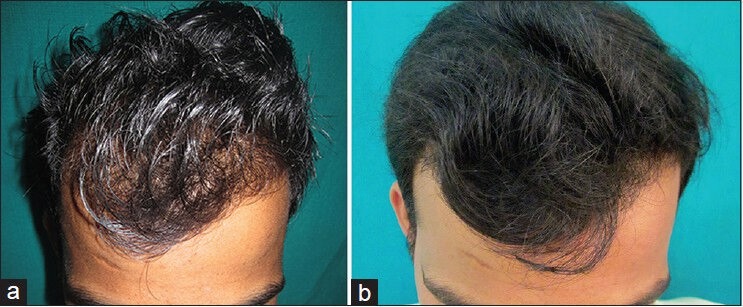Sir,
Platelet-rich plasma (PRP) represents a new bio technology that is part of the growing interest in tissue engineering and cellular therapy today. By definition, PRP is an autologous preparation of platelets in concentrated plasma. Although the optimal PRP platelet concentration is unclear, the current method by which PRP is prepared is reported to involve 300-700% enrichment, with high platelet concentrations.[1] Owing to these high concentrations of growth factors, PRP has been used successfully in periodontal therapy, maxillofacial surgery, orthopedics, and sports medicine and recently, PRP has attracted attention in the field of dermatology.
Over the past few years, research on the use of PRP in dermatology has taken on new meaning.[1] All studies on this topic vary in their methodology in one way or another; however, the similarity lies in the results. All show the beneficial effects of PRP on wound repair, differentiation and proliferation of adipose precursor cells, and angiogenesis.[2] Various growth factors, including platelet-derived growth factor, transforming growth factor, vascular endothelial growth factor, and insulin-like growth factor, are secreted from the α-granules of concentrated platelets activated by aggregation inducers.[2] These factors are known to regulate processes including cell migration, attachment, proliferation and differentiation, and promote extracellular matrix accumulation by binding to specific cell surface receptors.
Applications of PRP such as acne scars, fat grafting, wound healing, and hair regrowth have plenty of publications to boost about.[3] Newer combinations therapies such as PRP with carbon dioxide fractional lasers for acne scars,[4] PRP in hair transplantation as storage solution or PRP with microneedling are also being studied. Methods to increase the efficacy of PRP such as adding microparticles of dalteparin and protamine to help increase the hair caliber in hair transplant, have opened newer dimensions to research in platelet therapy.[5] Other rare indications mentioned in few case reports are lichen sclerosis,[6] striae distensae,[7] lipodermatosclerosis,[8] etc.
We conducted our own pilot study in Dr. D.Y. Patil Medical College and Research Center, Nerul, Mumbai, to determine the efficacy of PRP therapy given for androgenic alopecia (AGA), without the use of any other adjuvant therapy. Ten male patients with AGA Grade 2 or 3 were treated with weekly PRP for six sessions, and results were studied with global photography. On assessing the photographs, there was clinical improvement in only two patients [Figure 1a and b]. Rest of the patients showed no effect; however, all the patients were satisfied with the results. Hence, we concluded that subjective improvement is more than objective improvement in PRP. Hence, it can only be used as an adjuvant for therapy in hair loss and should not play a lead role in any treatment regime for AGA.
Figure 1.

(a) Before therapy, thinning of hair seen, (b) Posttherapy, increase in density of hair seen
Despite these abundant studies in various peer-reviewed journals, we await evidence-based data regarding the exact concentration and dosing parameters. All the studies are conducted with different methodology. Questions such as, when to inject PRP? Will PRP work better if injected weekly, daily, or monthly? For how long post procedure? Still boggle the mind. For now, all we have are arbitrary guidelines. Instead of being helpful and encouraging, these studies can often be confusing and misguiding to a doctor planning to inculcate PRP in his daily practice. These unanswered questions, plus the time and cost of equipment setup, are obstacles to widespread implementation of PRP.
It is undoubtable that the use of platelet-based formulations in cutaneous medicine will continue to evolve. Hence to use PRP to the fullest extent, the principles, procedure and indications need to be understood, standardized and simplified; only then, we can trust this procedure completely and give maximum benefit to our patients.
REFERENCES
- 1.Sclafani AP. Applications of platelet-rich fibrin matrix in facial plastic surgery. Facial Plast Surg. 2009;25:270–6. doi: 10.1055/s-0029-1242033. [DOI] [PubMed] [Google Scholar]
- 2.Cervelli V, Gentile P, Grimaldi M. Regenerative surgery: Use of fat grafting combined with platelet-rich plasma for chronic lower-extremity ulcers. Aesthetic Plast Surg. 2009;33:340–5. doi: 10.1007/s00266-008-9302-z. [DOI] [PubMed] [Google Scholar]
- 3.Oh DS, Cheon YW, Jeon YR, Lew DH. Activated platelet-rich plasma improves fat graft survival in nude mice: A pilot study. Dermatol Surg. 2011;37:619–25. doi: 10.1111/j.1524-4725.2011.01953.x. [DOI] [PubMed] [Google Scholar]
- 4.Lee JW, Kim BJ, Kim MN, Mun SK. The efficacy of autologous platelet rich plasma combined with ablative carbon dioxide fractional resurfacing for acne scars: A simultaneous split-face trial. Dermatol Surg. 2011;37:931–8. doi: 10.1111/j.1524-4725.2011.01999.x. [DOI] [PubMed] [Google Scholar]
- 5.Takikawa M, Nakamura S, Nakamura S, Ishirara M, Kishimoto S, Sasaki K, et al. Enhanced effect of platelet-rich plasma containing a new carrier on hair growth. Dermatol Surg. 2011;37:1721–9. doi: 10.1111/j.1524-4725.2011.02123.x. [DOI] [PubMed] [Google Scholar]
- 6.Casabona F, Priano V, Vallerino V, Cogliandro A, Lavagnino G. New surgical approach to lichen sclerosus of the vulva: The role of adipose-derived mesenchymal cells and platelet-rich plasma in tissue regeneration. Plast Reconstr Surg. 2010;126:210e–1. doi: 10.1097/PRS.0b013e3181ea9386. [DOI] [PubMed] [Google Scholar]
- 7.Suh DH, Lee SJ, Lee JH, Kim HJ, Shin MK, Song KY. Treatment of striae distensae combined enhanced penetration platelet-rich plasma and ultrasound after plasma fractional radiofrequency. J Cosmet Laser Ther. 2012;14:272–6. doi: 10.3109/14764172.2012.738916. [DOI] [PubMed] [Google Scholar]
- 8.Jeong KH, Shin MK, Kim NI. Refractory lipodermatosclerosis treated with intralesional platelet-rich plasma. J Am Acad Dermatol. 2011;65:e157–8. doi: 10.1016/j.jaad.2011.06.040. [DOI] [PubMed] [Google Scholar]


